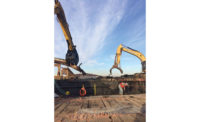Few construction professionals are more familiar with today's infrastructure crisis than the staffers of the country's various departments of public works-and few are more misunderstood. Unlike larger public owners that shepherd attention-grabbing mega-projects, DPW officials are routinely labeled as wrench-turning, snow-removing, garbage-collecting civic servants charged with small-potatoes projects not worthy of national interest.
DPWs are frequently stereotyped as managers of the nation's "roads and commodes, with the big yellow trucks for pushing snow," says Kurt Blomquist, public-works director for Keene, N.H., and a member of the American Public Works Association.
ENR's "Low & Slow Across America's Infrastructure" road trip visited with dozens of DPW officials to see how they are hustling to solve the ongoing challenges. The tour began in the Boston area in May, where the reconstruction of three dilapidated bridges alone stand to generate a third of a billion dollars in construction managed by Boston's DPW. At least one of the efforts is being accelerated.
In an emergency action in October of 2014, occupants and employees of 12 agencies on Long Island were evacuated without notice when a 65-year-old vehicle bridge serving the Boston Harbor island was deemed in danger of collapse. Boston's DPW contracted with Chicago-based Walsh Construction for the $23-million demolition of the Long Island Bridge's 16 spans stretching over 3,450 ft. The replacement span is estimated to cost over $100 million and take five years to complete. But recently elected Mayor Marty Walsh (D) is demanding his DPW complete the work in three years.
The city's Old Northern Avenue Bridge, a pedestrian crossing, also was closed in an emergency action in 2014, and DPW crews on the swing bridge were prohibited from occupying their work trailer. The North Washington Street Bridge, a vital hazardous materials crossing for trucks unable to use the Interstate 93 tunnels through the city's center, is a decaying danger that's been rated structurally deficient and functionally obsolete. Both superstructures will cost an estimated $100 million each to rebuild.
DPWs are not just first responders in emergencies; they also build long-term emergency infrastructure. "After Hurricane Sandy swept through New York City, we were nicknamed the Emerald City," explains Harry Weed, DPW superintendent for Rockville Centre, New York. "The village of Rockville Centre generates its own power. We're off the grid. When the superstorm knocked out New York City's power, Rockville Centre was glowing in the dark."
Rockville Centre's Mayor Francis Murray (D) encouraged Weed to continue expanding the reach of the town's public works after Sandy by submitting to a national flood-plan competition. Weed's efforts prevailed, winning a generous cut of a $125-million grant from the Hurricane Sandy Rebuilding Task Force and the U.S. Dept. of Housing and Urban Development.
Weed's work crews are set to begin building blue and green infrastructure in and along the Mill River. One of Long Island's most longest and most polluted inlets is set to be turned into Rockville's future gateway, complete with green space, mixed-use trails and natural and fabricated stormwater runoff systems.
DPWs also are partnering with other agencies to get critical civic projects off the ground. Kansas City, Mo., is rolling along with an ambitious effort that Sherri McIntyre, director of public works, manages.
"We've gone from advocating for the streetcar project to the construction of its two miles of track in a few short years." The $102-million project is due for completion in 2016. The support of city Councilman Russ Johnson, chairman of the local Transportation and Infrastructure Committee, a $37-million federal grant, "the actions of community and business leaders and the coordination of 27 utility companies are making the streetcar project possible," says McIntyre.


Post a comment to this article
Report Abusive Comment